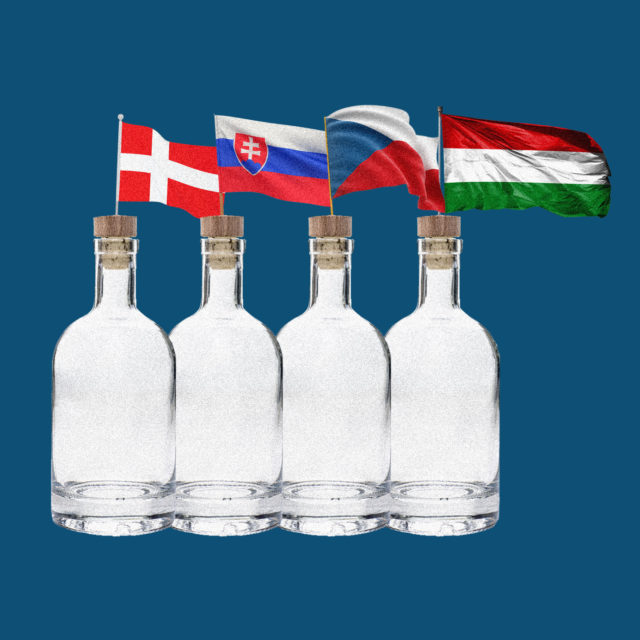The drinks world is in love with amaro. Bars dedicated to the Italian herbal liqueurs are opening everywhere from Dallas to Rome, while modern mixologists are giving popular brands like Averna a starring role in Black Manhattans and other contemporary cocktails.
But the Old World actually produces hundreds of traditional herbal bitters, of which Italy’s amari are just one subset. In particular, Central Europe is home to a range of relatively unknown varieties, from Slovakia’s Demänovka and Tatra Tea to Hungary’s Unicum, with uncountable numbers of similar beverages from Germany. Beyond rare breakouts like Jägermeister and Underberg, none of the central European bitters have the recognition of amaro brands like Fernet-Branca or Campari, though a few are gaining ground among cognoscenti and curious bartenders.
Jacob Grier, a bartender, drinks consultant, and the author of “Cocktails on Tap: The Art of Mixing Spirits and Beer,” says he has always considered amaro and the less well-known Central European bitters as being “in the same ballpark.”
“If I were to paint with a really broad brush, I’d say that I associate the Germanic liqueurs with more of a spice note, and the Italian amaro with more bitterness,” he says. As part of his consulting work, Grier created a cocktail for Wayfinder Beer, a brewery in Portland, Ore., that uses Aromatique, an herbal bitters from the German state of Thuringia.
“It’s essentially a Daiquiri that’s given extra flavor with the addition of Aromatique,” Griers says. “We called it the Green Heart Daiquiri in reference to the Green Heart forest in Thuringia.”
Another of Grier’s favorites? Denmark’s Gammel Dansk, which he describes as very complex, very bitter and far less sweet than many of its competitors.
“Because it’s so dry, it’s a way of adding bitter and spice notes to a drink without affecting the sweetness,” Grier says. Among other recipes, Grier has used it in a Negroni variation where every ingredient was split in two. “So instead of just using rum, I split it between Jamaican rum and cachaca. Instead of just sweet vermouth, it was a mix between sweet and dry vermouth, and instead of just Campari it was Campari and Gammel Dansk.”
Part of the appeal of such unusual bitters, Grier says, is how few American bartenders and drinkers are already familiar with them. Unlike the better-known brands from Italy, drinks like Gammel Dansk were not available in the U.S. for much of the country’s cocktail renaissance. “It doesn’t have any cocktail history, which is kind of a good thing,” he says.
With that tabula rasa, bartenders might feel free to use Central European bitters in unexpected ways, like the Sazerac variation featuring Gammel Dansk at Esker Grove in Minneapolis. In Chicago, Violet Hour has included Unicum and Unicum Plum in a number of unique cocktails, inspiring a Reddit thread on how to use the drinks.
When the influential bartender Kyle Linden Webster opened Portland’s Expatriate in 2013, he created a cocktail with a touch of Becherovka, a Czech herbal bitters that had recently become popular among his colleagues, if not among most consumers.
“Becherovka came into Portland and Oregon about eight years ago, and it immediately became beloved of bartenders, but there was no rep and no one to tell us what it was, so we just played around with it,” Webster says. The result was Ornament and Crime, a Becherovka-laced Whiskey Sour variation that immediately turned heads. “It was like something that nobody had had before,” Webster says. “Once I took it into the bar and worked out the specs, it became really popular, because drinkers were not used to having something familiar and unfamiliar at the same time.”
While brands like Becherovka and Unicum might have a following among some bartenders, the vast majority of Central European bitters are still not imported to the U.S., or at least not widely distributed. Among the myriad German elixirs known variously as Kräuterlikör (“herbal liquor”), Kräuterbitter (“herbal bitters”), or Magenbitter (“stomach bitters”), the country produces many brands that focus only on a specific ingredient, like Bärwurz, or “bear root,” the term for both the herb Meum athamanticum and the dozen or more herbal bitters that include it.
With a remarkably metal name that literally means “blood root,” Blutwurz bitters from Penninger, Ramelsberg, or Heike would seem like an easy sell in many markets. But unlike amaro, you probably won’t see a Blutwurz bar opening in your neighborhood anytime soon.
So why the love for amaro and not for Kräuterbitter? For Grier, it might have to do with the strong industry connection to brands like Campari, as well as the widespread love for Italian cuisine.
“There’s such a history of working with Italian liqueurs in the cocktail world, and there’s a lot of romance with the Italian gastronomy scene,” Grier says. “That doesn’t carry over to Germany.”
For Webster, the lack of a standout brand like Campari or Aperol means that many of Europe’s herbal liqueurs have almost been relegated to “a regional expression,” as opposed to part of a family of amaro. But if you can find them, he says, those regional expressions can add unexpected dynamics to drinks.
“It’s much more interesting to add a modifier that has some sugar and spice and some flavor to it, than to just add sugar,” he says.
Green Heart Daiquiri Recipe
As created for Portland’s Wayfinder Beer by Jacob Grier.
Ingredients:
- 1½ ounces rum
- ½ ounce Aromatique
- 1 ounce fresh lime juice
- ¼ ounce rich simple syrup (2:1)
Instructions:
- Combine ingredients with ice in a cocktail tin, and shake well to combine.
- Strain and serve up.
